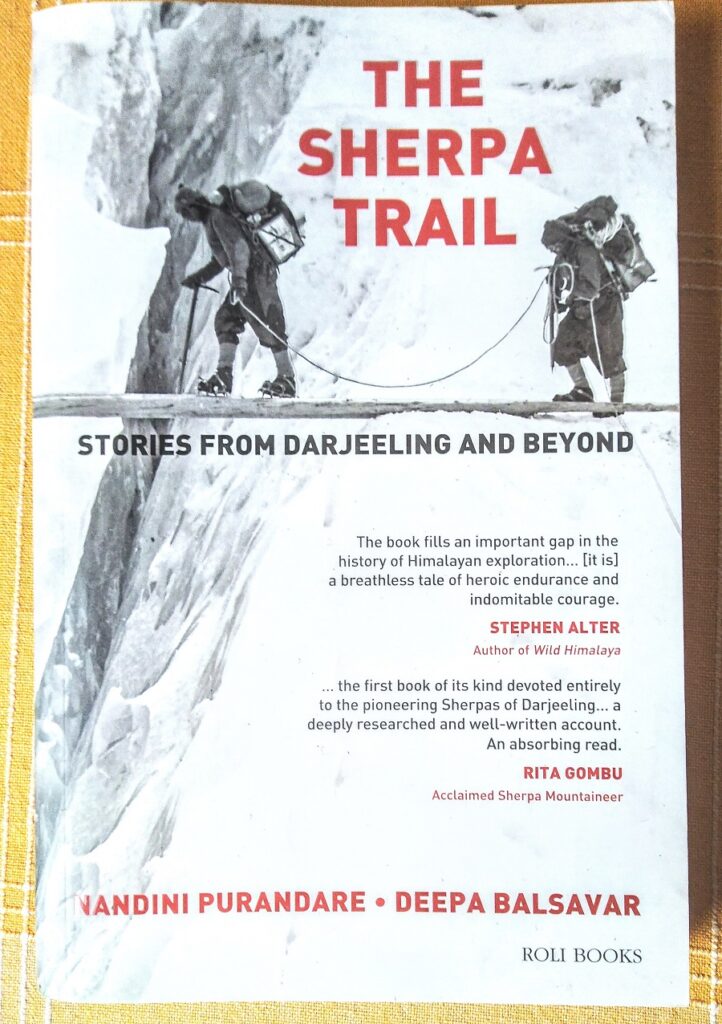Authors: Nandini Purandare and Deepa Balsavar
Published by: Roli Books
Price: Rs. 695.00
[ This review was published in THE TRIBUNE on 7th July 2024 ]
This book is a well deserved and long overdue tribute to perhaps the most recognizable group in the community of mountain climbers, but about whom next to nothing is known apart from their climbing exploits. The Sherpas are almost synonymous with the Himalaya and the 8000ers and their histories cannot be separated. This wonderful book, many years in the researching and writing, based on visits, interviews and documented records, finally does justice to this most intrepid, strong, courageous and loyal of our species.
The Sherpas (like the Bhutias) were originally residents of eastern Tibet and migrated to Nepal many hundreds of years ago. Subsequently, in the 19th and 20th centuries, there was a second migration to Darjeeling in India, once a part of Sikkim but annexed by the British in 1850. For Darjeeling was a two-way gateway: north to Nepal and Tibet for expeditions to the Himalaya and south for trade and other employment.
The age of climbing in the Himalaya began in the last two decades of the 19th century, as an extension of European and British imperialism, and that is when the Sherpa came into his own. Nepal was closed to foreigners till 1949 and so initially all attempts on the Himalayan peaks were through Darjeeling and Tibet. It soon became clear that the Alpine style of climbing and European supporting staff were unsuited for these altitudes and conditions, and so hundreds of native Lepchas, Bhutias and Sherpas were hired as porters and guides for these expeditions. A new profession was born and the Sherpas dominated it.
The book is a fascinating account of the history of mountaineering in the Himalaya, the various expeditions to different peaks like Everest, K2, Kanchenjunga, Nanda Devi, Dhaulagiri, Nanga Parbat; the conquests, failures and tragedies that resulted; the famous climbers associated with them and the roles played by the Sherpas in these attempts. It traces the evolution of the Sherpas from unnamed individual porters to their recognition as mountaineers par excellence, sealed by the achievement of Tenzing Norgay on Everest on 29th May 1953. The Sherpas now acquired names, faces, respect-and fame.
The book traces the establishment of THC (The Himalayan Club) in 1929 (out of its 250 members only one Indian, the Raja of Jubbal in HP, found a place in it!) to coordinate all climbing expeditions in the Himalaya and to extend the knowledge of the Himalayan ranges for the benefit of science, literature, art and sport; it also acted as a bridge between the Sherpas and the expeditions. We learn of two British ladies- Joan Townend and Jill Henderson- who as honorary secretaries of the THC contributed a lot to the recognition of the Sherpas as more than mere porters and did much for their welfare. Sadly, as much of the mountaineering (and Sherpas) shifted to Nepal after 1949 the THC’s role began to diminish. The process was speeded up by the setting up of the HMI (Himalayan Mountaineering Institute) in Darjeeling by Nehru in 1954, the Sherpa Climber’s Association by Tenzing in 1955 and the Indian Mountaineering Federation in 1961. But it had done its job well by then.
There are chapters on some of the legendary Sherpas such as Pasang Dawa, Ang Tharkay (probably the greatest of them all), Khamsang Wangdi, Nawang Gombu (the first person to have climbed Everest twice, Dorjee Lhatoo (the Clint Eastwood of Darjeeling!), Pemba Chorty (he has summitted Everest an incredible seven times), and Ang Tsering (who is reported to have discovered the footprint of a Yeti and received a hundred rupee bonus for it!), whose achievements matched that of Tenzing Norgay even as all the glory went to the latter.
There is a full chapter on the Sherpanis, Ani Lhakpa Diki (“the most gorgeous woman in all of Darjeeling”) and Ani Daku Sherpa, to remind the reader that the women of the tribe matched their male counterparts step for step, load for load, at least till base camp. These thumb-nail vignettes bring the reader into the homes of these doughty heroes, to give us a glimpse of their past, present and future. Their’s was a hard life: almost all of them were migrants from Tibet or Nepal, childhoods spent in poverty; they raised themselves to unprecedented heights, literally, by dint of sheer hard labour and commitment, and then reverted to humble retirement. Most did well by their families. They were legends in the climbing world, but are almost unknown outside of it. One achievement of this book is to have made them known to the larger world.
The authors also do their best to profile Tenzing himself, to contrast the pre-Everest and post-Everest hero. Where the former was an amiable, fun-loving, helpful individual the later Tenzing comes across as one full of grievances, petty jealousies and even vindictive. There is a strange bitterness that imbues his post-Everest innings: his autobiography, Tenzing After Everest, is a “litany of the injustices he faced”. All the adulation, success and riches appear to have gone to his head; he even turned against his former friend Ang Tharkay and had him evicted from HMI. In fact Captain Kohli, a member of the Indian Everest Expedition in 1962, went so far as to tell the authors in 2014: “ as a human being Ang Tharkay was a step further than Tenzing.” Some feel that he became “a slave to his greatness” but in extenuation it must be said that it could not have been easy for him , an uneducated man from a humble background, to have faced his global celebrity status and the pressures, demands and expectations that came with it. Though not a Sherpa himself, he made the Sherpa a household name. That, along with Everest, will remain his lasting legacy.
The book ends on a somewhat sombre and despondent note: that the golden age of the Darjeeling climbing Sherpa is now almost over, in fact , it quotes one great mountaineer as saying that in a decade from now there will be no Sherpas on the mountains. There are reasons for this: major expeditions to Everest (still the fulcrum of most climbing activity in the Himalayas) have shifted to Nepal and the younger Darjeeling Sherpas have followed suit, the present generation of younger Sherpas are not interested in doing what their fathers did- they are educated, ambitious and do not see either climbing or high altitude portering as a viable future, the HMI in Darjeeling has lost much of its lustre to the IMF (Indian Mountaineering Federation), its original Sherpas elbowed out by bureaucrats and army personnel, both as administrators and instructors. The elegy for this unique breed of mountaineers is perhaps best provided by Nima Norbu, an Everester himself and the brother of Tenzing Norgay’s third wife; this is what he told the authors of this book:
“Ninety-nine percent of the educated Darjeeling Sherpas are not going into mountaineering…There is no future for the climbing Sherpas of Darjeeling. When HMI opened-that was a different time. The whole system has changed. There are very few Sherpa instructors in HMI, and none in other institutes like Uttarkashi and Manali.”
This book ensures that when the Sherpa goes, he will not go unsung- or be forgotten.
| The author retired from the IAS in December 2010. A keen environmentalist and trekker he has published a book on high altitude trekking in the Himachal Himalayas: THE TRAILS LESS TRAVELLED.
His second book- SPECTRE OF CHOOR DHAR is a collection of short stories based in Himachal and was published in July 2019. His third book was released in August 2020: POLYTICKS, DEMOCKRAZY AND MUMBO JUMBO is a compilation of satirical and humorous articles on the state of our nation. His fourth book was published on 6th July 2021. Titled INDIA: THE WASTED YEARS , the book is a chronicle of missed opportunities in the last nine years. Shukla’s fifth book – THE DEPUTY COMMISSIONER’S DOG AND OTHER COLLEAGUES- was released on 12th September 2023. It portrays the lighter side of life in the IAS and in Himachal. He writes for various publications and websites on the environment, governance and social issues. He divides his time between Delhi and his cottage in a small village above Shimla. He blogs at http://avayshukla.blogspot.in/ |



